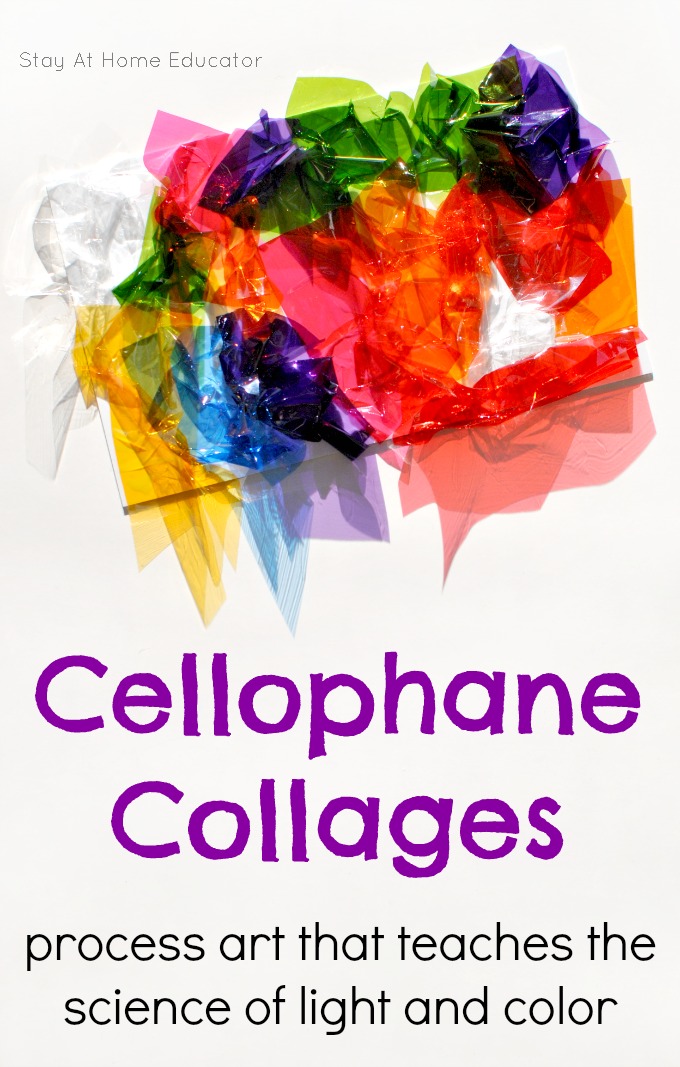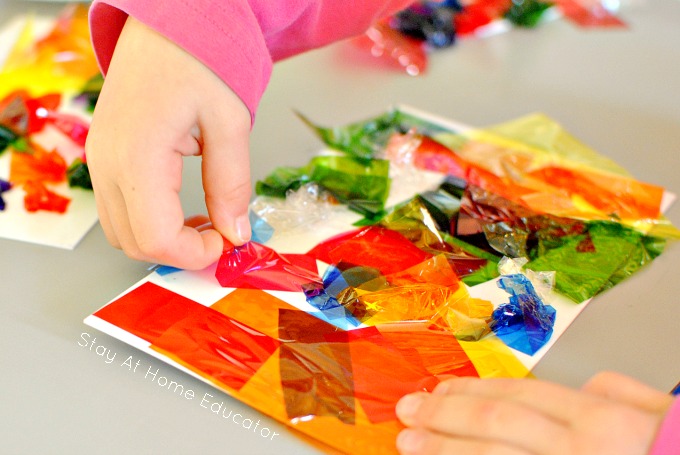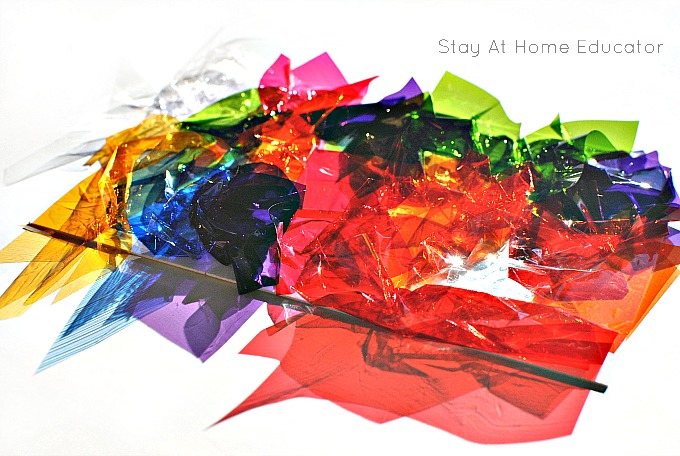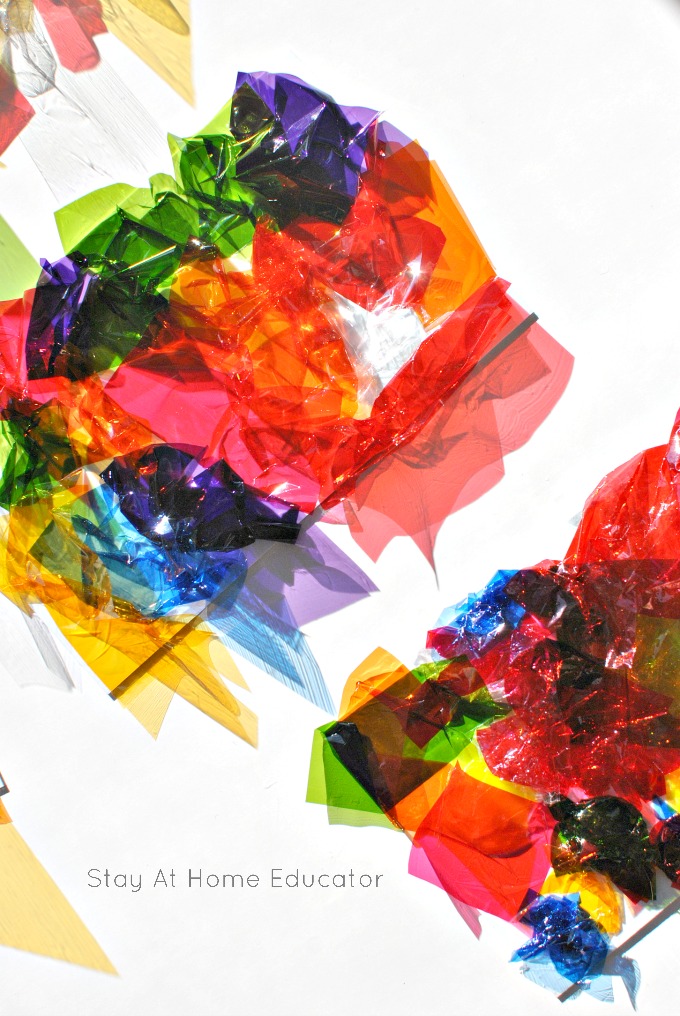Cellophane collages are where process art meets science and then they go a-walking and meet sensory. But the best part of a project like cellophane collages is that it is such an ideal way to teach preschoolers about light and color.
This is an amazing activity! I know, I just said it, and it’s so true! It has so many elements it can’t be pigeonholed into just one category.
It’s art. It’s science. It’s sensory.
But I have to admit they were not my idea. The first time we made these was at our local art museum for what is called “Toddler Wednesday”. For a minimal fee, toddlers and preschoolers can enjoy a short art lesson followed by an art project. They do such a wonderful job of bringing both classic and modern art ideas to the children. It’s so engaging.
I am green with envy over their art-based playroom as well. It has a huge chalk board wall, giant magnetic pattern blocks for another wall, a light table with all sorts of acrylic table scatter to explore, as well as multiple sets of rainbow stackers and rainbow stacking towers. There are, of course, severaldrawing easels with pencils, markers, and chalks, and a book nook, too.
It is an excellent place to spend a Wednesday morning with the kids. When we got home from making our cellophane collages, my kids proudly displayed them on their dressers. The evening sun pours into their bedroom, shining right on the collages, creating the most beautiful and colorful display of shadows on the wall.
Which brought me to the idea of recreating them with my preschoolers during our science lessons where we are doing lots of activities with light and color. I quickly found that cellophane is the best way to teach preschoolers about light and color, not to mention it provides sensory input for little learners as well.
You Might also Like
Valentine’s Suncatchers
How to Write Art Lesson Plans
Free Art Lesson Plans for Preschoolers
Cellophane Collages
Materials
- cellophane sheets in rainbow colors
- self adhesive mounting boards
- scissors
- tray
The Set-Up
Begin by inviting your preschoolers to help cut down the cellophane sheets into smaller pieces. The shape of the pieces don’t matter, but strips work nicely. For younger prechoolers, you might want to do this step for them. Because cellophane is flimsy, it can be difficult to cut for preschoolers who are still at the early stages of handling scissors and cutting properly. And, the scissors need to be nice and sharp since a dull pair of kid scissors will just fold the cellophane between the blades.
Place the cellophane strips on a tray. Write the preschooler’s name on the back and then set out a self-adhesive mounting board for each preschooler. Invite them to peel the backing off, as though it is a “giant sticker“. Make sure they understand not to touch the sticky back if they can help it.
Process Art That Teaches the Science of Light and Color
The brief lesson at the art museum discussed glass art. The museum teacher showed examples of glass art and specifically pointed out the colors layered in the glass. She used a flashlight to demonstrate how light flows through the colored glass and creates colored shadows on the white walls.
This is exactly what we discovered as we made our cellophane collages.
The preschoolers laid on their pieces of cellophane, slowly and deliberately. They immediately noticed the noise cellophane makes when it is handled. They layered the pieces on their adhesive boards, pushed them together, and pulled them back apart.
The preschoolers quickly discovered that the cellophane created new colors when the pieces layered upon one another. The sunshine shone through the partially open blinds. It hit our preschool table with slivers of direct sunlight and they saw first hand how the light made colored shadows. Some of the preschoolers held pieces of cellophane in front of their hands or their classmate’s faces, making them turn colors.
When the projects were finished I pushed open the blinds and we came upon the most beautiful discovery of all. How beautiful the cellophane collages look in total and complete sunlight! We probably spent fifteen minutes admiring our work.
It was pretty spectacular! The children oohed and awed over their creations, which changed based on the way it was laid in the sunlight. They found that their art exceeded the mounting board and poured onto the white poster board we had laying underneath. As they turned their colleges in different directions, the colorful shadows changed into different shapes, almost like dancing puppets.
Hmmm…shadow puppets would make another great activity to teach preschoolers about light!
Fun Facts About Light and Color
In our unit study about light and color, we explored these fun facts.
- Not all light can be seen by humans.
- Light travels in wavelengths. The length of the wave determines it’s color. Purples are the shortest and reds are the longest. (Hmmm…kinda like a rainbow in the sky).
- Some animals see light in wavelengths that humans cannot, meaning that some animals can see colors that humans can’t. Insects, for example, can see ultraviolet wavelengths, but humans cannot. And, insects cannot see as many reds as humans can.
- We see colors because of the way light either reflects off an object or gets absorbed by an object.
- Wavelengths traveling through teeny, tiny droplets of water (humidity from recent rain) bends in just the right way to create a rainbow.
- Prisms are created by bending and reflecting light through a piece of glass.
- For more information, see here.
You Might also Like
Ocean Discovery Bottle
Beautiful Kid-Made Ornament
Color Theory for Preschoolers
Teaching Preschoolers About Light and Color
Teaching preschoolers about light and color is such a fun preschool theme to explore. I adore all the “wow” moments! Hands-on activities like these cellophane collages are the perfect way to teach preschoolers about light in a way that is tangible to them. Many concepts about the science of light are extremely complex. However, this activity takes an otherwise abstract concept and makes it more concrete and accessible to young children who are so very, very interested in colors.
I remember it was a rather impulsive decision to head to the art museum that day. I believe it was one of those days were you just have to get out of the house with the kids if you want to survive the day. I’m so glad we did. If we hadn’t, my kids would have missed out on this awesome lesson and project. And I, myself, would not have been so inspired to study light and color in such a way with my preschoolers.
This year the study of light was a mini unit of just a week. Next year I’ll reserve an entire month to teach preschoolers about light and color. I have so many other great ideas now and it was evident how much my preschoolers adored the activities.

I’m Sarah, an educator turned stay-at-home-mama of five! I’m the owner and creator of Stay At Home Educator, a website about intentional teaching and purposeful learning in the early childhood years. I’ve taught a range of levels, from preschool to college and a little bit of everything in between. Right now my focus is teaching my children and running a preschool from my home. Credentials include: Bachelors in Art, Masters in Curriculum and Instruction.





Such a fun project and I love the color! I’ll be featuring you on Tuesday as one of our creative art ideas from the Discover & Explore linky — thanks for sharing and I hope you’ll link up again!
What a great activity … I love that it even includes color mixing! I pinned your post to my Kids’ Art Projects board at http://pinterest.com/debchitwood/kids-art-projects/
So pretty!
Thanks for sharing on Kids Get Crafty!
Maggy
This is such a great art, science, and sensory project all in one! I’d love to invite you to share it at Teach Me Tuesday at Preschool Powol Packets–I hope to see you there!!